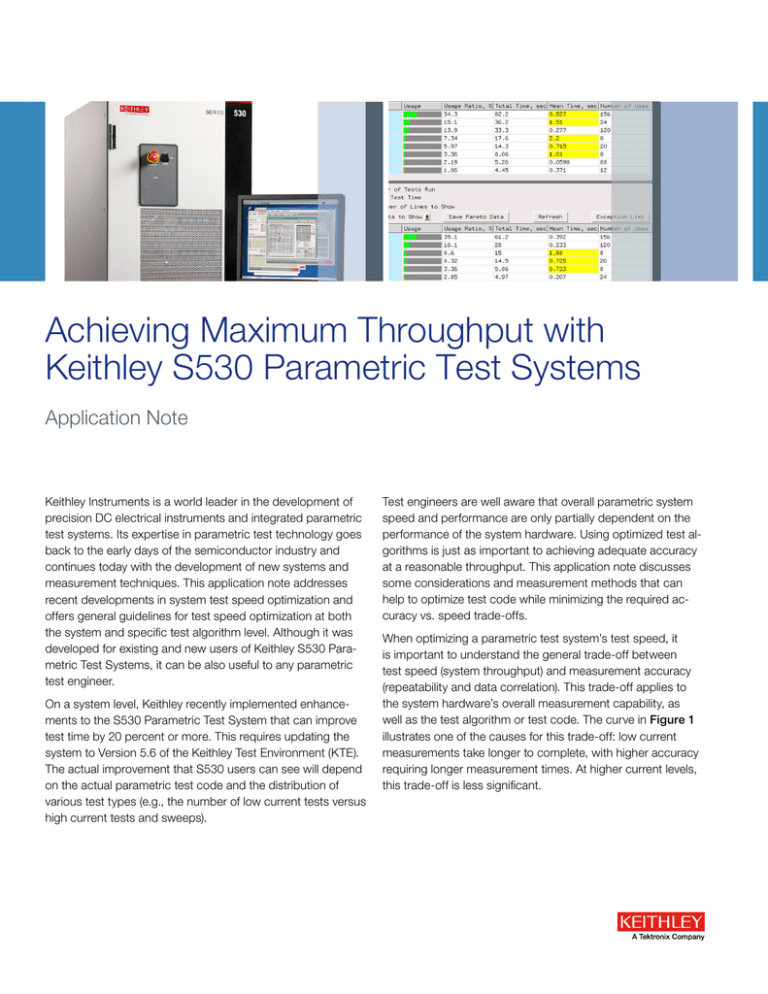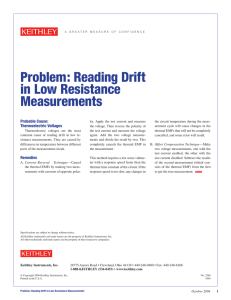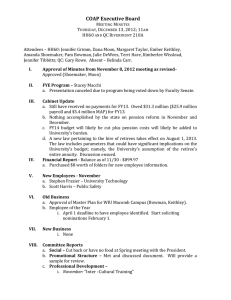
Achieving Maximum Throughput with
Keithley S530 Parametric Test Systems
Application Note
Keithley Instruments is a world leader in the development of
precision DC electrical instruments and integrated parametric
test systems. Its expertise in parametric test technology goes
back to the early days of the semiconductor industry and
continues today with the development of new systems and
measurement techniques. This application note addresses
recent developments in system test speed optimization and
offers general guidelines for test speed optimization at both
the system and specific test algorithm level. Although it was
developed for existing and new users of Keithley S530 Parametric Test Systems, it can be also useful to any parametric
test engineer.
On a system level, Keithley recently implemented enhancements to the S530 Parametric Test System that can improve
test time by 20 percent or more. This requires updating the
system to Version 5.6 of the Keithley Test Environment (KTE).
The actual improvement that S530 users can see will depend
on the actual parametric test code and the distribution of
various test types (e.g., the number of low current tests versus
high current tests and sweeps).
Test engineers are well aware that overall parametric system
speed and performance are only partially dependent on the
performance of the system hardware. Using optimized test algorithms is just as important to achieving adequate accuracy
at a reasonable throughput. This application note discusses
some considerations and measurement methods that can
help to optimize test code while minimizing the required accuracy vs. speed trade-offs.
When optimizing a parametric test system’s test speed, it
is important to understand the general trade-off between
test speed (system throughput) and measurement accuracy
(repeatability and data correlation). This trade-off applies to
the system hardware’s overall measurement capability, as
well as the test algorithm or test code. The curve in Figure 1
illustrates one of the causes for this trade-off: low current
measurements take longer to complete, with higher accuracy
requiring longer measurement times. At higher current levels,
this trade-off is less significant.
Application Note
Figure 1: Sensitivity vs. typical execution time for connect-force-measure for different current levels.
Test time optimization strategies and
approaches
Overall system test speed is a function of the total time of all
the individual test programs and is always determined by two
factors: overall system performance and the design of the
user test programs. Although both are equally important, let’s
first address optimizing the user test programs.
Optimizing large production testing at the cassette or wafer
level is no trivial task, as opposed to focusing on optimization
of specific individual test programs. Many Keithley systems
customers have employed the following approach, often in
cooperation with Keithley applications engineers.
terms of its percent contribution; the fifth column displays the
average test time per test/macros. Analysis is performed for
individual tests and those same measurements made within
test macros (typically subsite-level test programs). Improvements in the test times for only a few top test time contributors provides predictable test time improvement for a full
wafer lot test. For example, by reviewing the individual tests
shown in Figure 2 and reducing the test times for “vt” to 0.24
seconds and for “beta” to 1 second, overall test time can be
improved by approximately 10 percent. Only two test types
must be changed to realize this improvement. Pareto data
makes it easy to identify the few tests that need speed optimization. Prioritizing the effort will produce the greatest benefit
for the time invested in adjusting the test code.
Optimization and test time improvement must be performed
in conjunction with correlation analysis that compares the
new measurement data with historical data. Because test
time improvement always has the potential to cause data
shift, which is unacceptable in semiconductor process control
monitoring (PCM), it is preferable to minimize the number of
changes needed to achieve the maximum possible benefit.
This application note doesn’t address the complications associated with correlation issues because there are too many
options to consider and experience with device physics and
device design knowledge are usually required. However, to
ensure successful and effective correlation issue resolution,
cooperation between the test engineer and the device engineer is essential.
Best practices and standard test
scenarios
By considering some specific test scenarios, it’s possible to
identify considerations and approaches that should help to
minimize test times with little or no data quality trade-off.
Low current/leakage measurement optimization
Figure 2: Test time distribution in Pareto analysis.
The first step in this approach is to create a time log file for
a full wafer lot test by enabling software flags. Each individual test is logged. Then all tests are grouped by type, for
example, “vt” test, “beta” test, “breakdown” test, etc. As
shown in Figure 2, a Pareto report is created using one of the
Keithley system software tools, ptlog. The first column shows
the name of the test or test macros (in KTMS section). The
second and third columns show relative usage of the test in
2
www.tektronix.com
Leakage or Ioff measurement is the measurement of currents
ranging from 1nA to 0.1pA. The dynamic range of a source
measure unit (SMU) instrument depends on the power line
cycle (PLC) integration time and is typically within four to five
digits of the measurement range. For example, to measure
1pA-level leakage, the SMU current range must be set to
10nA or lower. As mentioned previously, current measurement
test time increases dramatically on low current ranges.
Real device leakage is usually much smaller than what is actually measured for PCM. Leakage tests rarely measure actual
device leakage. Usually, this test returns a value that is a function of the lowest allowed current range, device ­capacitance,
Achieving Maximum Throughput with Keithley S530 Parametric Test Systems
SMU settling, and user delay. Therefore, to some degree,
leakage measurements can be “dialed in.” There’s no point
to waiting a long time to measure a small leakage value that
doesn’t represent any physical property. From a PCM perspective, it’s important to establish some reasonable leakage
floor for the leakage measurements (for example, 2–10pA) to
optimize test time.
Two undesirable things usually happen in the tests. For large
capacitors, it takes a long and unknown time to charge the
capacitor fully to reach breakdown voltage. This time can be
characterized in the lab. But in the production environment,
when a large number of tests must be done quickly, this test
becomes difficult to run. Also, some breakdown structures
may show degradation of the hold voltage with time.
Therefore, to optimize leakage tests, the minimum required
current value for each device must be established first. Based
on this value, choose the minimum allowed current range. If
the minimum required current is 10pA, then limit the lowest
allowable measurement range to (1e-11 * 1e4 = 1e-7) 100nA
using these commands:
lorangei(SMU1, 1e-7); //limits the lowest allowed range
setmode(SMU1, KI_INTGPLC, PLC); //sets integration
time to PLC
measi(SMU1, &dummy); //dummy measurement, used here
to bring the range to the appropriate setting
intgi(SMU1, &Ioff); //measurement with integration over PLC
In the calculation above, 1e4 represents four digits of SMU
dynamic range. Keithley recommends using a PLC integration setting of 0.1PLC (1.6ms of test time at 60Hz,) or possibly
up to 1PLC (16ms) for low current measurements. Of course,
these settings are simply recommendations and ultimately
must be revised after the test engineer and PCM data specialist consider them. With KTEv5.6, 1pA to 5pA measurements
now settle in the range of 0.2 to 0.3 seconds, depending on
the bias level.
Voltage breakdown measurements
The voltage breakdown test, which is widely used to characterize the electrical strength of various structures, can be
performed in two ways. The most common technique sweeps
voltage, stopping at some level of the current. The second
technique forces current and directly measures breakdown
voltage. Both techniques have limitations that must be understood to allow accurate evaluation of the breakdown voltage
at a minimum time.
Voltage sweep is the slowest technique because it usually
measures a large number of points. Decreasing the number
of points and speeding up the slew rate may lead to false
measurements, given that there is capacitive displacement
current ( ) that can be comparable to the requested current
trigger level and cause a trigger at a smaller, premature voltage levels.
The main disadvantage of the second technique is the dependency of voltage on the test time in poorly designed tests.
Figure 3: Example of breakdown voltage test (voltage vs. time)
For breakdown voltage tests, Keithley recommends using a
properly designed “force current” technique using the following sequence:
1. Force test current.
2. Monitor voltage vs. time.
3. Stop the test when the latest measured voltage is less
than the previous one or if the voltage slope decreases
significantly. The test should timeout if it exceeds the
time limit.
Implementing this sequence allows measuring breakdown
voltages as fast as possible, with no dependency on the test
time. Figure 3 illustrates an example of a non-destructive
breakdown test. This test should stop when the V(t) slope
becomes horizontal. Keithley applications engineers can provide S530 system users with further examples of a properly
designed breakdown test.
Transistor threshold voltage (Vth) tests
Transistor characterization or, more specifically, threshold voltage measurement is an example of a very common test that
usually represents a significant portion of the overall PCM test
time. Extrapolated Vth at maximum gm is an industry-standard technique that provides a very stable threshold voltage
measurement. In this technique, gate voltage is swept over a
range of voltages. From the IdVg array, the threshold voltage is
www.tektronix.com
3
Application Note
calculated from intercept of the IdVg tangent curve at maximum transconductance (Figure 4).
speed benefits. Many Keithley systems users have used this
learn-range capability successfully in test programs.
Capacitance measurement optimization,
“smart” offset measurements
Offset or “chuck down” measurements are required for capacitance tests. In poorly designed tests, this offset measurement is performed for each test instance. Some system users
perform offset measurement once per wafer or per lot and do
not have a time penalty for this redundant measurement. They
still have to organize the data flow and use multiple naming
conventions to use previously measured values reliably.
Figure 4: Id/Vg data for threshold voltage measurement.
One common mistake in the implementation of the test is the
measurement of drain current in auto-range mode. In these
tests, most of the test time is taken up by the measurement
of the Ioff current; the Vth value is calculated from only two
or three points at the intercept line. Therefore, once again,
the simplest fix for bloated test times is to control the lowest
allowed current measurement range using this command:
lorangei(DRAIN_SMU, 1-e4);
This allows the measurement to be done in auto-range mode
but fixes the lowest allowed range to 1e4, which provides
adequate current resolution at the 1.0A–0.1µA level of drain
current. Limit the number of sweep points used to about 30.
Increasing the number of points does not improve accuracy of
the extracted Vth; instead, it can actually degrade the accuracy due to smaller voltage steps, which will increase data noise
in the digital differentiation.
“Learn-Range” optimization techniques
Keithley has developed several implementations of adaptive
testing, in which test program content changes based on test
results. The data-driven design of the Keithley Test Environment (KTE) facilitates this capability. Test data can be easily stored and retrieved in the test program. However, given
that data manipulation is a capability that can be used in any
environment, test program engineers might find the following
suggestion useful when using any hardware.
Previous test results, such as threshold voltage or drain current measurements, can be used to accelerate an executing
test program, by storing and retrieving data from a previous
site and adjusting the current test according to the expected
value of the result. Usage and optimization of the test in accordance with the expected value can provide significant test
4
www.tektronix.com
In general, Keithley recommends making test code adaptable
and intelligent. Capacitance tests should handle data manipulation internally by defining a unique keyword that includes
used pins and test conditions. The test code then should use
this keyword to measure, store, and retrieve the offset value
if needed. This allows for one offset value measurement per
wafer lot, does not require management of off-values in the
test program, and scales to test programs of any size. Actual
test code implementation can be provided to Keithley system
users upon request or training.
Test time optimization recommendations
Several general considerations and recommendations are
useful in optimizing test times.
One of most common ways to handle correlation issues is the
use of the delay function. Although it does help “fix” some of
the tests quickly, it is typically used when there is insufficient
time on the production floor to understand the root cause of
the correlation problem and resolve it properly. The need to
charge capacitive devices fully makes a longer delay necessary. It’s important to note that the most recent generation
of Keithley system SMUs do not exhibit “range compliance.”
In earlier generations of DC instruments, the current from
the SMU was limited to the set current measurement range,
which made it necessary to wait for full charge. This need
was especially pronounced on lower current ranges, such as
0.1µA and lower. Newer Keithley system SMUs eliminate the
need to wait for full charge and allow faster “force V/measure
I” operation. “Force I” mode is unaffected by this consideration. The best way to handle capacitive load situations and
eliminate the need for any delay is live monitoring of current in
the test and proper specification of exit criteria. This would allow eliminating artificial delays and making tests independent
of arbitrary delay settings.
Another suggestion that is obvious but often overlooked in
many optimization efforts is the use of fixed ranges when-
Achieving Maximum Throughput with Keithley S530 Parametric Test Systems
ever possible. Although the advantage of auto-range tests
is self-evident because auto-ranging allows the use of the
same test for a wide range of measurements, the use of a
fixed range provides some extra time improvement in many
scenarios. A breakdown test is a good example: the trigger
current is known and a fixed current range could be set to
10*TriggerCurrentValue to enhance accuracy and speed with
no trade-off.
At lower current values, it is advantageous to use the integration function (intgi(SMU, &I);) instead of any delay. For
example, for currents measured in the range of 1µA to 1nA,
the proper PLC setting should be about 0.1, which is 1.7ms
(1 PLC being equal to 1/60th of a second or 16.7ms). This
time is small relative to the total time of a standard test, but it
provides better accuracy than the standard measure current
(measi(SMU, &I);) function. For lower currents, 1.0 PLC will
provide a better trade-off between test time and accuracy.
S530 recent system improvements
As mentioned previously, Keithley has enhanced both the
S530 system hardware and software (KTEv5.6) to focus primarily on speed improvement. Overall improvement of system
test speed will be approximately 20 percent without any test
code changes and little or no impact on data correlation. The
overall throughput improvement possible will depend on the
specific use-case or mix of devices and measurements.
S530 system and KTEv5.6 software speed improvements
come from several areas:
• Low current test speed: Settling times on the lower SMU
current measurement ranges have been improved to speed
up measurement. Although sub-picoamp measurements
previously took approximately two seconds to settle, settling time for the same measurement now takes approximately 0.2 seconds.
• Improvement in sweeps: KTEv5.6 leverages the sweep capabilities inherent in the S530’s system SMUs. Each range
used in a multi-range sweep has unique built-in delays (i.e.,
lower current measurement ranges with longer delays than
higher measurement ranges). By using the new setmode
command KI_DELAY_FACTOR, this delay factor value is
multiplied by the built-in delay associated with each range.
With sweep functions often representing a large portion
of overall wafer test time, significant time savings can be
realized with this new approach to managing delay settings
within KTE.
• Device initialization [devint() speed-up]: This command is
used to (re)initialize the system and is used at the end of
most tests. This function was streamlined in KTEv5.6, and
because it is used so frequently, the cumulative time savings is substantial.
• New Keithley DMM: The previous generation DMM used in
S530 systems was designed more for bench applications
and was controlled via GPIB. Keithley’s latest DMM is designed for high-speed system applications and is controlled
via Ethernet. As a result, S530 measurements such as
differential voltage and low resistance can now be made at
substantially higher speeds.
• New System Speed Mode: Users can change overall
system speed easily by modifying the system configuration
file. As discussed previously, there is always a performance
trade-off between speed and accuracy. The system speed
mode options are FAST, LEGACY and CUSTOM. The
fast mode is now the default setting and provides a speed
improvement of approximately 20 percent over previous
versions of S530 KTE software. The legacy mode setting provides performance compatible with previous KTE
versions. Several system speed improvements are tied
to System Speed Mode, including the new DELAY_FACTOR setting described previously. This feature can also be
used with individual tests or test macros with the setmode()
­command.
Figure 5: Modifying icconfig_QMO.ini for changing system speed mode (FAST,
LEGACY)
Figure 6: Modifying icconfig_QMO.ini for change system speed mode (CUSTOM)
Optimization cases
As stated previously, enhancements to the S530 and its
system software (KTEv5.6) can improve overall measurement
time (at the wafer or lot level) by approximately 20 percent
without requiring any user test code changes. It is possible
that correlation for a few of the measurements will drift outside
the acceptable PCM window and may require adjustment.
But even in this case, that improvement of approximately 20
percent should still be achievable.
www.tektronix.com
5
Application Note
Now, consider various cases in which S530 users not only get
the benefits of the latest S530 system and software enhancements but also apply some of the optimization techniques discussed here. Keithley has examined three different use-cases
to assess the total test time improvement from the system
and software enhancements in conjunction with optimization efforts. The first case is for general semiconductor wafer
test, which includes common tests for semiconductor wafer
PCM structures. The second case is wafer test that includes
a higher percentage of sweep measurements. The last case
includes a higher percentage of low current measurements.
With both system and software enhancements plus optimization efforts, improvements ranging from 25 to 40 percent were
realized across this range of use cases. The actual timing
improvement data will depend on the type of test program,
the amount of built-in hardcoded delay, and the contributions
of various tests, such as leakage tests vs. high current tests,
amount of voltage sweeps, and capacitance measurements.
The actual level of test speed improvement depends on the
use case; for example, a case with a large fraction of leakage
or low current tests will differ from a case with a significant
fraction of the voltage sweeps. Some test code contains a
large number of built-in delays. These delays can be removed;
however, this will require correlation effort and time. And different tests provide different levels of potential speed gain vs.
time invested.
Figure 7: Test time, Pareto distribution, before (above) and after (below) installing most recent KTE update.
Figure 7 shows a before-and-after example of the recent
S530 system and software enhancement benefits. Sample
6
www.tektronix.com
data was collected on an actual wafer in which the total test
time decreased from 240 to 179 seconds for 4 sites, amounting to a 25 percent test speed improvement. The test program contains about 250 tested parameters and includes
well-known or standard tests. In this case, the test type distribution tilts slightly towards a higher number of breakdown
tests and voltage sweeps.
This example does not include any further improvement that
can be achieved using optimization techniques of user test
code as described earlier in this application note. The test
speed improvement represents only that associated with the
system and software enhancements. On average, additional
optimization of user tests usually brings another 5 to 20 percent improvement, depending on the initial optimization level
of the original code.
The most important columns in the analysis are Usage Ratio
and Mean Time. Usage Ratio determines the priority for
further test code improvement, and Mean Time determines
the feasibility of the improvement. The yellow highlighting is
identifies tests longer than 0.6 seconds, which have a higher
chance of optimization success.
Summary and suggestions for action
To summarize, Keithley continues to explore and develop
ways in which the S530 Parametric Test System can make
PCM-acceptable measurements faster than previously possible. This application note outlines the combination of system
hardware, software, and applications knowledge necessary to
achieve continuous improvement. The most recent enhancements are associated with KTEv5.6 system software, which
can provide test time improvements of 20 percent or higher,
depending on the wafer test case. This is obviously good
news for existing S530 system users who can upgrade their
systems and for those considering new systems.
To optimize test speed vs. accuracy or repeatability still
further, a new software tool (time breakdown with ptlog that
generates Pareto data) allows for a quick test speed analysis
of the whole wafer-level test, and identifies areas for potential
improvement. Specific optimization techniques and trade-off
considerations for the most common tests, such as leakage tests, threshold voltage measurements, and breakdown
tests, were also discussed. Keithley applications engineers
are available for consultation with S530 users and their test
program needs.
Contact Information:
ASEAN / Australia (65) 6356 3900
Austria 00800 2255 4835
Balkans, Israel, South Africa and other ISE Countries +41 52 675 3777
Belgium 00800 2255 4835
Brazil +55 (11) 3759 7627
Canada 1 800 833 9200
Central East Europe and the Baltics +41 52 675 3777
Central Europe & Greece +41 52 675 3777
Denmark +45 80 88 1401
Finland +41 52 675 3777
France 00800 2255 4835
Germany 00800 2255 4835
Hong Kong 400 820 5835
India 000 800 650 1835
Italy 00800 2255 4835
Japan 81 (3) 6714 3010
Luxembourg +41 52 675 3777
Mexico, Central/South America & Caribbean 52 (55) 56 04 50 90
Middle East, Asia, and North Africa +41 52 675 3777
The Netherlands 00800 2255 4835
Norway 800 16098
People’s Republic of China 400 820 5835
Poland +41 52 675 3777
Portugal 80 08 12370
Republic of Korea 001 800 8255 2835
Russia & CIS +7 (495) 6647564
South Africa +41 52 675 3777
Spain 00800 2255 4835
Sweden 00800 2255 4835
Switzerland 00800 2255 4835
Taiwan 886 (2) 2656 6688
United Kingdom & Ireland 00800 2255 4835
USA 1 800 833 9200
Rev 0415
For Further Information
Tektronix maintains a comprehensive, constantly expanding
collection of application notes, technical briefs and other
resources to help engineers working on the cutting edge of
technology. Please visit www.tektronix.com
Copyright © 2015, Tektronix. All rights reserved. Tektronix products are covered
by U.S. and foreign patents, issued and pending. Information in this publication
supersedes that in all previously published material. Specification and price
change privileges reserved. TEKTRONIX and TEK are registered trademarks
of Tektronix, Inc. All other trade names referenced are the service marks,
trademarks or registered trademarks of their respective companies.
0921151KW-60241-0





